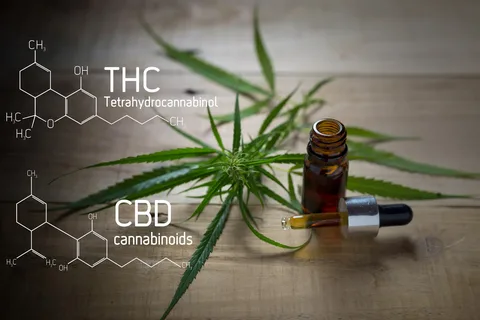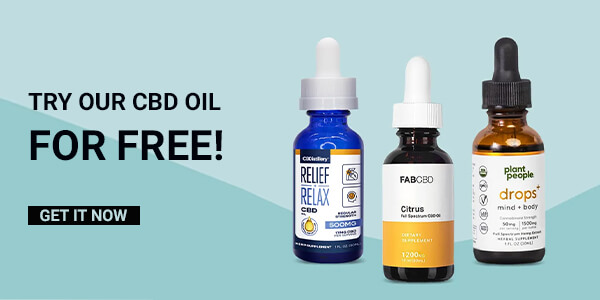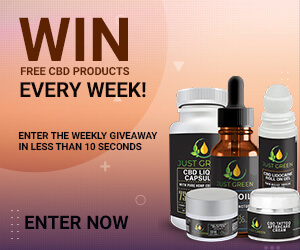Over the past few years, the ever-growing interest in CBD and THC has flooded the cannabis market, which has prompted a high visibility of products overall.
And while cannabis products continue to flourish, often offering cannabinoids such as CBN or CBG, CBD and THC remain the most popular, and continue to exude the most evidence behind their benefits.
And it’s safe to say that this expanding interest will only continue to grow, especially as more states legalize it.
Different products have also emerged containing CBD, THC, or both, and they may be designed to alleviate ailments such as stress, anxiety, and insomnia.
With the growing prevalence of products containing CBD and THC, it’s understandanle that more users are asking about the potential side effects.
To better understand the side effects of CBD and THC, it’s still important to first understand the differences between these two cannabinoids.
What is CBD?
Also known as cannabidiol, CBD is not only both non-psychoactive and ideal for a low-key evening, but also the second most abundant cannabinoid produced by the plant, making it particularly accessible.
What is THC?
Also known as tetrahydrocannabinol, THC is often considered the main cannabinoid produced in cannabis with psychotropic properties. In plants, this concentration also distinguishes hemp and marijuana, since cannabis plants containing more than 0.3% THC by dry weight are considered marijuana, which means it may be illegal in some regions.
The most noticeable effect of THC is the rush of euphoria brought on, specifically through the CB1 receptors in the brain, which help trigger the release of dopamine. Dopamine plays a crucial role in regulating your feelings, moods, and pleasure.
Key Differences Between CBD and THC
Both THC and CBD impact the endocannabinoid system, which is known for playing an important role in maintaining homeostasis. Additionally, researchers are still making progress toward understanding cannabis and all of its cannabinoids. Still, they know that it has an association with regulatory processes such as memory, appetite, sleep, mood, and fertility.
While THC and CBD share similarities, some key differences between the two compounds are worth noting.
To begin, both CBD and THC possess a chemical makeup that strongly resembles the body’s natural endocannabinoids, which work as chemical messengers that relay signals between nerve cells in the body. They play an important role in a wide range of functions including sleep, pain, appetite, mood, and the immune system.
CBD and THC have the same molecular structure, but there are differences in how these molecules are arranged that are responsible for the differing effects. By mimicking endocannabinoids, they bind with receptors and cause different effects in the body.
While CBD can come from either hemp or marijuana, it is often derived from hemp to avoid the addition of larger amounts of THC. THC, on the other hand, is derived from marijuana.
CBD that comes from marijuana may contain more THC, which may not be ideal for people trying to avoid THC. Some CBD products that are produced from cannabis, for example, may contain more THC than the label suggests.
Finally, CBD and THC affect different receptors in the brain. Because of this, CBD typically does not have psychoactive effects—in other words, it won’t cause you to get high.
THC, on the other hand, does have psychoactive effects. It is the compound that produces the high that people associate with marijuana.
How CBD and THC Work Together
THC and CBD are both structured in a fairly similar way. What’s more is that they resemble endocannabinoids present in the human body.
But what, exactly, are endocannabinoids?
To begin, the human body has what’s known as the endocannabinoid system (ECS), which is a complex biological network consisting of cannabinoid receptors, enzymes, and cannabinoids which work as neurotransmitters.
Endocannabinoids are crucial for regulating many vital processes, including immunity, functions of the nervous system, sleep, appetite, and more. These endocannabinoids bind to CB1 and CB2 receptors located throughout the body to maintain homeostasis (balance). So whether it’s regulating pain, stress, or mood, they play a crucial role in how your body reacts to your environment.
Because THC and CBD both possess chemical structures that mimic the body’s natural endocannabinoids, THC tends to bind to the receptors present in the body, thus prompting various physiological and psychological responses.
While THC binds directly to the receptors, CBD does it indirectly. And since CBD affects how the receptors send signals, this might explain why it doesn’t produce psychoactive effects like THC.
CBD is known to reduce the number of enzymes responsible for breaking down endocannabinoids which, in turn, naturally elevates endocannabinoid levels produced by the body.
Further, this affects cannabinoid receptors and even non-cannabinoid receptors such as opioid receptors, which can be quite sensitive to various neurotransmitters present in the brain.
Understanding the Entourage Effect
While the term “entourage effect” might sound like a hot new example of lingo for some folks, it’s been used longer than most most people might think, dating back to a
1999 article written by chemists Raphael Mechoulam and Shimon Ben-Shabat, theorizing that the cannabinoids, terpenes, flavonoids in cannabis coordinate to create a therapeutic effect, which has made it into everyday jargon as “the entourage effect.”
And at the time, the theorization behind this effect was somewhat controversial, as it contradicted the traditional belief that THC was the prime player in cannabis.
The chemists theorize in this paper that every part of the plant may play a role in the effects of cannabis on the brain. However, they believed that fatty acids were particularly important in enhancing an entourage effect.
Further, they suggest in the paper that these fatty acids not only elevated the mechanisms of the phytocannabinoids found in cannabis, but also the activity of the body’s natural endocannabinoids.
What Ratio of THC to CBD is Best?
THC and CBD may provide more benefits when taken together rather than separately. Still, it’s worth noting that cannabinoids will affect everyone differently–both CBD and THC. What’s more, someone who might use cannabis products to unwind at the end of the day will experience something different from someone who takes it for their fibromyalgia.
Consulting your healthcare provider is always a good start if you’re interested in CBD and THC. They can help review any potential drug interactions while shedding light on the right THC:CBD ratio for your needs.
Additionally, remember that both THC and CBD may cause side effects. THC, for starters, is psychotropic, and it may cause symptoms such as dry mouth, delayed reactions, impaired memory, and anxiety in some people.
Side Effects of CBD
Currently, there is only one FDA-approved CBD product: Epidiolex, which is typically used to treat two rare forms of epilepsy. And yet, the evidence about how CBD affects the body is still quite limited.
During the review and approval process for Epidiolex, using CBD was found to have potential risks and side effects, such as drug interactions, an increased risk of sedation, stress, panic, or sleep disorders. Potential side effects also include changes in alertness, diarrhea, and a reduction of appetite.
Additionally, the FDA has not evaluated CBD for effectiveness in unapproved products, and no assessments have been made regarding the ideal dosage for the average user.
It’s also been recommended by doctors to only use products that a third party has tested for potency and contaminants, such as heavy metals or pesticides.
Most CBD product websites should have a Certificate of Authenticity. We advise avoiding those that do not.
Side Effects of THC
With THC, common side effects may include changes in blood pressure or heart rate, dizziness or drowsiness, a slight flush in the face, digestive disturbances, and some impairment in respiratory function.
It’s also worth noting that experts are still uncertain about what long-term effects marijuana has on the mind and body, especially when it comes to the country’s younger demographic.
The most common side effects of weed include:
- Dizziness or drowsiness.
- Flushing of the face.
- Gastrointestinal disturbances.
- Changes in blood pressure.
CBD and THC Drug Interactions
With the rising popularity of cannabis as a therapeutic product, it makes sense that more individuals are wondering about the potential drug interactions it may prompt.
That being said, it’s important to understand that just about everything in the body interacts with each other, due to the complex mechanisms it must perform.
And while cannabis products such as CBD and THC are generally considered safe to use, consumers are advised to take caution if they’re on any drug regimen, as there is potential for interactions between cannabis and conventional medications and alterations to how the body metabolizes drugs.
When any medication or substance enters the body, it must be broken down, or metabolized.
Metabolism happens all throughout the body, but one of biggest players consist of cytochrome P450 (CYP450), which are a family of enzymes that work together to convert foreing substances for excretion.
But sometimes, CYP450 can be affected by other drugs or substances, whether it’s slowing it down or accelerating it. This alteration can have an effect on the metabolism overall, especially when it comes to certain supplements or medications.
And this is important, because research indicates that CYP450 metabolizes CBD and THC–specifically through enzyme CYP3A4, which is responsible for over half of the market’s clinically-prescribed medications.
Sometimes, CBD interferes with CYP3A4, which can cause drugs in the body to remain inactive.
Any alteration or blockage of the CYP450 pathway can considerably impact the uptake of a broad range of substances.
Due to CBD’s potential to suppress CYP2D6 and CYP450 enzymes, patients must avoid using cannabis in conjunction with most prescription pharmaceuticals.
CBD Drug Interactions
CBD has garnered both attention and appeal for its potential to ease symptoms related to conditions such as insomnia, anxiety, chronic pain, and a host of other health conditions.
And as studies continue to highlight the potential benefits of CBD, many people are already giving it a try.
Currently, research indicates that CBD is a safe substance that’s known to possess few, if any, minor side effects. However, there is one major caveat that should be considered: CBD does have the potential to interact with some medications. The concern has to do with how the body metabolizes certain substances.
CBD may decrease or increase the liver’s drug metabolization rate, reducing the medication’s overall efficiency and enhancing the risk for marijuana drug interactions.
Likewise, CYP3A4 inhibitors increase the THC concentration in the bloodstream, leading to prolonged elimination from the system and potential unpleasant effects.
THC also acts as a CYP1A2 inducer, which may cause THC drug interactions resulting in decreasing the serum concentrations of prescription medications such as:
- Chlorpromazine
- Olanzapine
- Haloperidol
- Naproxen
- Cyclobenzaprine
- Clozapine
- Duloxetine
CYP450 metabolized prescription medications that may cause drug interactions with marijuana include oral hypoglycemic agents, sulfonylureas, NSAIDs, PPIs, Antidepressants, Immune modulators, Benzodiazepines, and more.
Before trying CBD, it’s important to discuss with your doctor about any supplements, prescription, and over-the-counter medications you’re taking.
Your doctor will likely be equipped to assist users in determining a CBD product, dosage, and schedule that’s compatible with any regimen you might already have. And in some cases, your doctor may want to monitor blood plasma levels of any medications you may be currently on.
Don’t discontinue the usage of any of your medications to try CBD, unless your doctor says it’s safe to do so.
Also remember that like lotions, creams, and salves, topical CBD products may also demonstrate an option. This is because oils, edibles, and vaping products like cartridges, topicals don’t typically enter the bloodstream, unless they’re specifically designed to.
And while studies designed to determine potential interactions between CBD and specific medications are still in the works, the rule of thumb is to avoid CBD if your medications have a grapefruit warning on the label.
And in this warning, people taking the medication are advised to avoid eating or drinking any grapefruit or grapefruit juice.
And according to the FDA, consuming grapefruit while on one of these medications can lead to a higher concentration of the medication in the bloodstream and adverse side effects or even an overdose.
It’s also worth noting that over 85 drugs interact with grapefruit and some closely related citrus juices.
THC Drug Interactions
THC drug interactions, meanwhile, are slightly more complicated.
The combination of CYP3A4 inhibitors and THC slightly boosts THC levels in the bloodstream, leading to adverse effects and the prolonged elimination of THC from the body.
Due to THC being a CYP1A2 inducer, further THC drug interactions are also possible as it can decrease the serum concentrations of prescription drugs such as:
- Chlorpromazine
- Haloperidol
- Olanzapine
- Cyclobenzaprine
- Naproxen
- Duloxetine
- Clozapine
Is it Safe to Combine CBD and THC?
Both THC and CBD are known to already co-exist together in cannabis plants, and if you’ve ever consumed a high-THC cannabis product, there’s a good chance you’ve mixed CBD and THC already. Cannabis is naturally rich in cannabinoids, including THC and CBD.
So to clarify, yes. Mixing CBD and THC is something that users should be able to safely do, because of the theorized synergistic connection known as entourage effect, which suggests that cannabinoids work better together, rather than separately. And since the joining of hemp-derived products such as CBD in the legal marketplace, we tend to hear quite a bit about full-spectrum CBD. Since full-spectrum CBD is essentially a hemp-derived CBD product with a cannabinoid and terpene profile that’s full and abundant.
Final Thoughts
CBD and THC both offer a wealth of potential benefits that are quickly gaining attention. And while they’re both considered safe, be advised to consider the possibility of side effects and interactions with other drugs you’re taking, and consult your doctor or a qualified healthcare professional before use and if you have any questions.
Crystal is a qualified doctor and a sex and relationships adviser at Dimepiece LA. In her spare time, she enjoys nature and is a budding tennis enthusiast. Crystal is involved with several governmental and educational initiatives aimed at increasing awareness about sexual health and making free advice more accessible to everyone.
[email protected]
- Vape Kit By Vapesourcing-The Ultimate Vape Kit Comprehensive Review - October 12, 2023
- Gummies By Dietsmoke-Comprehensive Review of the Finest Gummies - October 5, 2023
- CBD Oil vs. Tinctures: What’s the Difference? - February 4, 2023








